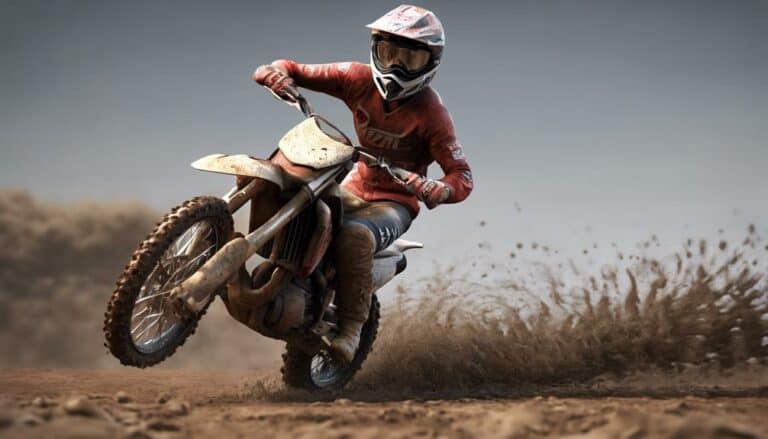Have you ever wondered why mastering the rear brake is considered a cornerstone of successful dirt bike riding?
The rear brake serves as a pivotal tool for piloting challenging terrain and executing precise maneuvers on the track. Understanding the nuances of brake modulation and weight transfer can greatly impact your performance and safety while riding off-road.
By diving into the key braking fundamentals for dirt bike riding, you'll uncover essential techniques that can elevate your skills to the next level.
Key Takeaways
- Mastering front and rear brake dynamics is crucial for effective dirt bike braking.
- Proper body positioning enhances stability and control while braking on dirt trails.
- Balancing front and rear brake usage optimizes grip, traction, and cornering control.
- Modulating brake pressure based on terrain conditions ensures safe and efficient dirt bike riding.
Braking Techniques for Dirt Bikes
Mastering braking techniques on a dirt bike is important for maximizing control and performance on varied terrains. When it comes to braking, understanding the dynamics of the front brake, rear brake, and body position is essential. Let's start with the rear brake, which plays a significant role in maintaining control and stability. By using the rear brake effectively, you can slide the bike into corners, setting yourself up for better entry speed and smoother turns.
Before delving into front brake usage, focus on mastering rear brake control. Adjusting brake pressure based on terrain conditions is key to optimizing stopping power. Proper body position while braking ensures stability and prevents the bike from sliding out. Remember, the rear brake is your friend when it comes to traversing tricky sections or tight corners.
Importance of Proper Braking
Understanding the vital role of proper braking technique is paramount for maintaining control and stability while traversing challenging terrains on a dirt bike. When it comes to dirt bike riding, the way you apply your brakes can make all the difference. Here are three key reasons why mastering proper braking is essential for your off-road adventures:
- Front Tire Grip: Proper braking distributes weight to the front tire, increasing grip and traction, allowing you to maneuver through obstacles with precision.
- Utilizing the Rear Brake: Engaging the rear brake effectively helps in controlling speed, preventing skidding, and maintaining stability on uneven surfaces.
- Achieving Better Control: Balancing front and rear brake usage, along with engine braking, grants you better control over your bike, especially in tight corners and steep descents.
Mastering Brake Control
Shifting your focus to rear brake control enhances stability and allows for tighter turns when riding dirt bike trails. Mastering rear brake control is important for maintaining balance and control over your bike. By utilizing the rear brake effectively, you can adjust your speed smoothly and navigate challenging terrain with confidence.
Brake modulation is another important skill to master. It involves applying the brakes progressively rather than squeezing them abruptly. This technique prevents skidding and helps you maintain stability during braking. Practice adjusting your brake pressure according to the terrain and conditions to optimize control and traction.
Additionally, incorporating engine braking into your riding technique can further enhance your control and stability on dirt tracks. Engine braking involves using the resistance of the engine to slow down the bike, reducing the reliance on the brakes alone.
Understanding Brake Balance
Achieving a harmonious balance between your front, rear, and engine braking techniques is important for optimizing control and performance while riding your dirt bike on various terrain types.
When it comes to understanding brake balance, remember these key points:
- The rear brake stabilizes the bike, providing control and preventing the rear wheel from skidding.
- The front brake offers the majority of the stopping power, allowing you to control speed effectively.
- Avoid relying solely on the front brake alone, as this can lead to loss of traction and potential accidents.
To master brake balance, progress from focusing on the rear brake to eventually achieving a 50/50 balance between front and rear brake inputs. Adapt your brake pressure based on terrain conditions; for example, rely more on the rear brake in sandy or loose surfaces.
Regular practice of brake balance ratios and adjustments is crucial for honing your braking skills and enhancing performance on your dirt bike.
Braking Safety Tips
To enhance your dirt bike riding safety, prioritize mastering proper braking techniques and strategies. When riding dirt bikes, understanding how to utilize the rear brake effectively is essential for maintaining control and braking efficiently.
On loose surfaces, rely more on the rear brake to provide stability and prevent the front wheel from washing out. Remember to apply the brakes gradually to avoid skidding or losing control, especially in challenging terrains. Practice modulating brake pressure to adjust to varying conditions and terrains, ensuring best traction at all times.
Smooth and progressive brake application is key to avoiding wheel lock-up, which can lead to dangerous situations. By understanding the terrain you're riding on, you can adapt your braking technique accordingly, enhancing both safety and control while enjoying the exhilarating experience of dirt bike riding.
Stay mindful of these braking safety tips to ride confidently and responsibly.
Conclusion
As you navigate the rugged terrain on your dirt bike, remember that mastering the art of braking is like finding your balance in life. Just as you control your speed and direction with precision, so too must you find harmony in the chaos around you.
Embrace the power of your brakes, feel the ground beneath you, and let the symphony of dirt and rubber guide you towards greatness.
Ride on, fearless warrior of the dirt!

